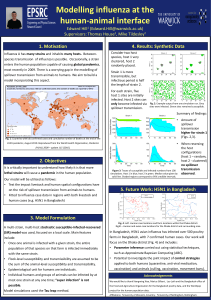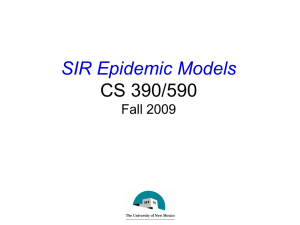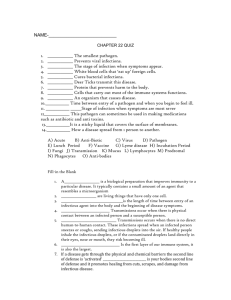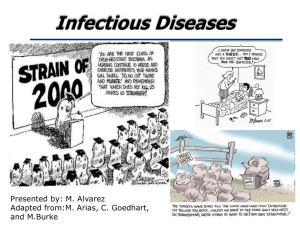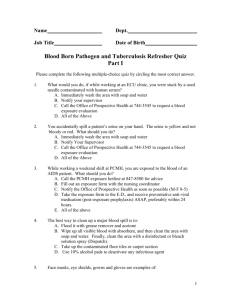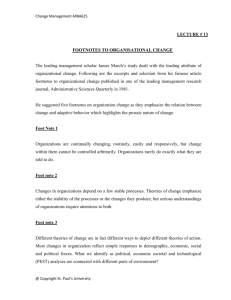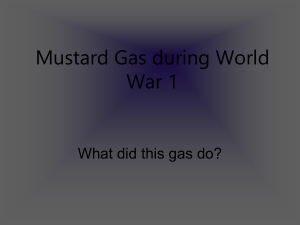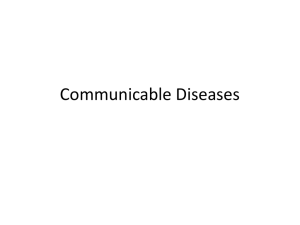Supplementary Material - Proceedings of the Royal Society B
advertisement
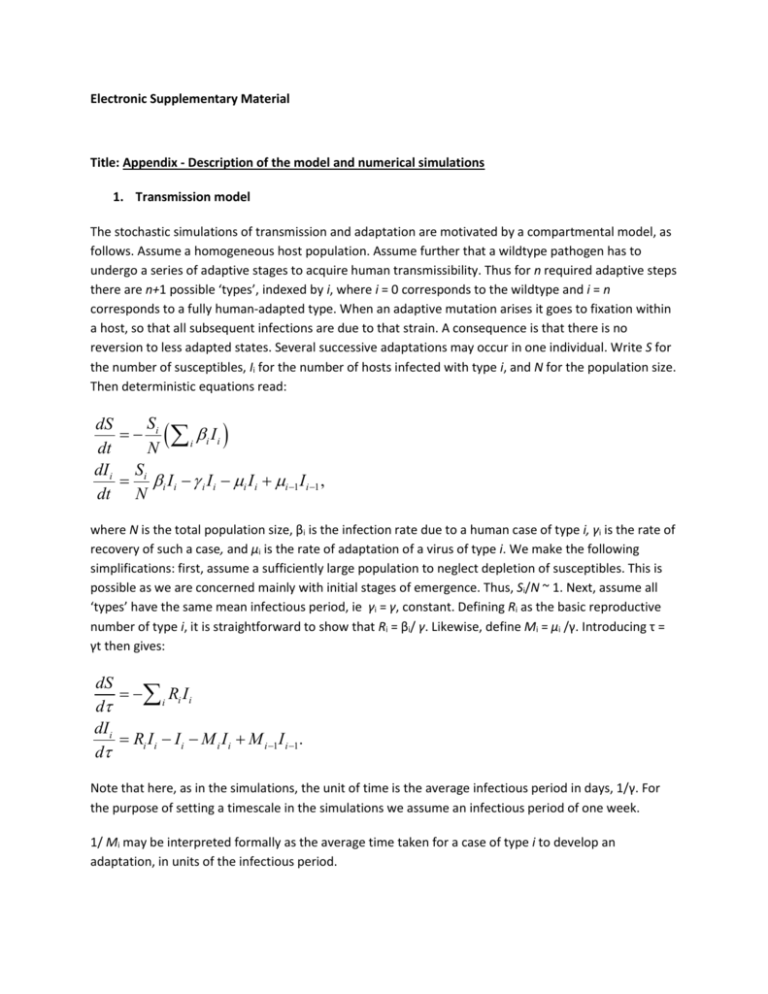
Electronic Supplementary Material Title: Appendix - Description of the model and numerical simulations 1. Transmission model The stochastic simulations of transmission and adaptation are motivated by a compartmental model, as follows. Assume a homogeneous host population. Assume further that a wildtype pathogen has to undergo a series of adaptive stages to acquire human transmissibility. Thus for n required adaptive steps there are n+1 possible ‘types’, indexed by i, where i = 0 corresponds to the wildtype and i = n corresponds to a fully human-adapted type. When an adaptive mutation arises it goes to fixation within a host, so that all subsequent infections are due to that strain. A consequence is that there is no reversion to less adapted states. Several successive adaptations may occur in one individual. Write S for the number of susceptibles, Ii for the number of hosts infected with type i, and N for the population size. Then deterministic equations read: S dS i i i Ii dt N dI i Si i I i i I i i I i i 1 I i 1 , dt N where N is the total population size, βi is the infection rate due to a human case of type i, γi is the rate of recovery of such a case, and μi is the rate of adaptation of a virus of type i. We make the following simplifications: first, assume a sufficiently large population to neglect depletion of susceptibles. This is possible as we are concerned mainly with initial stages of emergence. Thus, Si/N ~ 1. Next, assume all ‘types’ have the same mean infectious period, ie γi = γ, constant. Defining Ri as the basic reproductive number of type i, it is straightforward to show that Ri = βi/ γ. Likewise, define Mi = μi /γ. Introducing τ = γt then gives: dS i Ri I i d dI i Ri I i I i M i I i M i 1I i 1. d Note that here, as in the simulations, the unit of time is the average infectious period in days, 1/γ. For the purpose of setting a timescale in the simulations we assume an infectious period of one week. 1/ Mi may be interpreted formally as the average time taken for a case of type i to develop an adaptation, in units of the infectious period. 2. Simulation The system described above is translated into a stochastic simulation, in continuous time, using the Gillespie algorithm (18). Given a time τ and a state vector n(τ), whose ith entry is the number of people infected with strain i at time τ, there are 3P possible next events, where P is the total number of infecteds at time τ: each infected can, as above, transmit, recover, or develop an adaptation. With each possible event we associate a ‘weight’, as follows: R0(i) (Transmission from an individual infected with strain i) 1 (Recovery of an individual infected with strain i) M(i) (Mutation in an individual infected with strain i) so that the sum of these weights over all individuals is s = ∑i ni(R0(i)+1+Mi). Dividing each of the weights by s, we find the next-event-probabilities for each of the above described events. Generating a uniformly distributed random number between 0 and 1 determines which of these events happen next, and to which individual: the time to this event is given by c = – log(r)/s, where r is a second random number uniformly distributed between 0 and 1. Thus we obtain an updated state vector, n(τ + c). Given an index human case of a wildtype pathogen, the above process is repeated until there are zero remaining infected cases (extinction), or there are sufficiently many cases that the probability of ultimate extinction is less than 10-6 (emergence). This probability is given by R0-m, for m cases of a pathogen with R0 > 1. The choice of 10-6 is an arbitrary one; indeed, it may argued that in some cases a more conservative threshold probability of, say, 0.5 could be adopted. However, even such a relatively high probability does not materially affect the results presented here: as discussed in the text, large, self-limiting clusters arise not from adapted strains, but from those marginally below adaptation. Title: Appendix - Extensions to the model The results presented in the text assume, for simplicity, that all clusters are due to a single zoonosis. To simply model the effect of multiple introductions in the same cluster, we assume here that the number n0 of such introductions is a Poisson random variable, conditioned on n0 ≥ 1, that is: Pr(n0 = k) = λk/[k!(eλ-1)], k ≥ 1. In the example of H5N1 influenza, an upper bound on λ is given by assuming that all human cases have been zoonoses. Thus, data from Indonesia (World Health Organization 2009) suggests that λ ≤ 0.14. Figure A1 shows cluster size distributions before emergence, assuming λ = 0.14. It also incorporates evolutionary courses involving seven adaptive stages, a greater number than presented in the text. Despite these modifications, qualitative properties of adaptive and gradual scenarios remain unchanged. 10 Frequency 10 5 10 0 10 0 2 4 6 8 10 10 Frequency 10 5 10 0 10 0 10 20 30 40 50 Cluster size 60 70 80 Figure A1: Simulated cluster size distributions for an ‘extended’ model, incorporating seven adaptive stages and the possibility of multiple index human cases arising from a single zoonotic host. See caption, figure 3, for an explanation of these plots. Here the punctuated scenario (upper graph) has R0 = [0, 0.1, 0.1, 0.1, 0.1, 0.1, 2] and the gradual scenario (lower graph) has R0 = [0, 0.1, 0.3, 0.6, 0.9, 1.4, 2]. Both cases have M = [0.1, 0.1, 0.1, 0.1, 0.1, 0.1, 0]. Video of series of introductions leading to emergence Description: Animations illustrating the accumulation of outbreaks before emergence of an adapted virus, for both the punctuated and the gradual scenarios. (Please see movie file sent separately)

